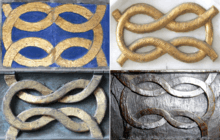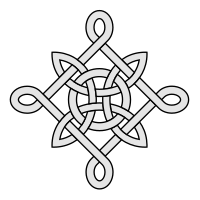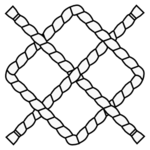Heraldic knot
A heraldic knot (referred to in heraldry as simply a knot) is a knot, unknot, or design incorporating a knot used in European heraldry.[1] While a given knot can be used on more than one family's achievement of arms, the family on whose coat the knot originated usually gives its name to the said knot (the exception being the Tristram knot). These knots can be used to charge shields and crests, but can also be used in badges or as standalone symbols of the families for whom they are named (like Scottish plaids). The simplest of these patterns, the Bowen knot, is often referred to as the heraldic knot in symbolism and art outside of heraldry.

Bourchier knot compilation, Tawstock Church, Devon
Heraldic knots
| Example | Knot name | Description |
|---|---|---|
 |
Bourchier knot | [2] |
 |
Bowen knot | |
 |
Heneage knot | |
 |
Lacy knot | |
| Savoy knot | ||
 |
Wake knot | |
 |
Harrington knot | |
References
- Eve, George W. (1907). Heraldry as Art: An Account of Its Development and Practice, Chiefly in England. Batsford. pp. 279-280. Retrieved 28 November 2018.
- Gough, Henry (1894). A Glossary of Terms Used in Heraldry. J. Parker. p. 133. Retrieved 28 November 2018.
This article is issued from Wikipedia. The text is licensed under Creative Commons - Attribution - Sharealike. Additional terms may apply for the media files.